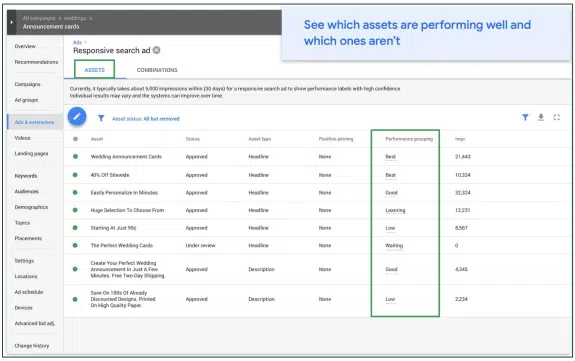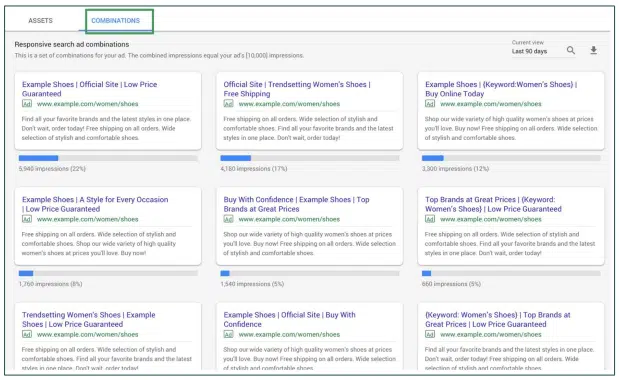4 ways to optimize your responsive search ads
ETAs will be deprecated in less than a year. At SMX Next, Frederick Vallaeys provided marketers with tactics that can help them get the most out of their RSAs, before they're forced to make the switch.
Google’s responsive search ads (RSAs) have existed alongside the original expanded text ads (ETAs) since May 2018, giving marketers more formats for their campaigns. Since then, RSAs have not only become the default, but are set to be the sole text ad format going forward.
“As we’ve suspected, RSAs will become the only ad format that you’re going to be able to use, at least as far as a plain text ad,” said Frederick Vallaeys, co-founder and CEO of PPC management software company Optmyzr, in his session at SMX Next.
Marketers would be wise to start optimizing RSAs to stay ahead of their competitors. Here are four tactics Vallaeys recommends marketers use to improve their effectiveness.
Use more headline variants
Headline variants can allow marketers to use more keywords, which can enable their RSAs to reach more potential customers.
“If you give Google more variations then the CTR goes up because they’re able to show the right ad to the right user at the right time,” said Vallaeys.
However, spikes in CTR don’t necessarily correlate with increased conversion rates. Data shows they actually decrease with more headlines.

Fortunately, adding more headlines also increases total impressions as it gives Google more flexibility to create the ideal ad for each situation, leading to more impressions per RSA.

“Conversion rate seems to go down the more variety you introduce,” Vallaeys said, “But at the end of the day, the thing we care about is impressions and conversions per ad unit.”
“We recommend taking full advantage of all the flexibility Google gives you, using those 15 headline variations and all the descriptions as well,” he added.
Analyze asset labels
Google Ads’ asset labels show which assets are performing well and which assets you should replace after the RSAs serve. Vallaeys recommends watching these assets for two weeks, then replacing those that are underperforming.

“This is when you open up your RSA and you look at the different headlines and description lines,” said Vallaeys.
“This label they [Google] give you is based on actual performance,” he added, “So it’s a good thing to optimize against.”
Review combination reports
The combinations report show marketers what ad combinations are served up most often. These can provide marketers with insights into how Google’s optimization algorithms are working — and whether any mistakes have been made.
“It’s a good thing to look at to make sure there’s no crazy ad text combinations,” Vallaeys said. “If you’ve used a number of headlines, Google could put it together and all of the sudden it says something you’re not happy with. This is a great place to see what are the most common combinations of ads that Google serves.”

The assets in these reports should be reviewed to see how many impressions they’re receiving as well. If certain assets receive low impressions, it might be time to replace them.
Put smart bidding automation in place
Marketers should combine automation to help prevent ads from showing up to the wrong groups, Vallaeys says.
“If you’re doing manual bidding and letting Google show your RSAs to less-likely-to-convert audience members, then that’s problematic because your manual bids are not going to handle that,” said Vallaeys.
“But if you combine smart bidding with Google automatically showing the right ad — even doing a little bit more broad match — you can get good results,” he added.

This tactic is backed up by search data as well. Marketers who switch from ETAs to RSAs, using the same assets, in campaigns that use broad match and smart bidding see an average of 20% more conversions at a similar cost per conversion, according to Google.
A mix and match approach to bidding like this can help marketers get the most out of Google’s automation. And, the ability to use A/B testing within the RSAs can help achieve the desired results. If automation is the future of search ads, marketers would be wise to use Google’s machine learning systems to their fullest extent.
Watch the full SMX Next presentation here (registration required).
Contributing authors are invited to create content for Search Engine Land and are chosen for their expertise and contribution to the search community. Our contributors work under the oversight of the editorial staff and contributions are checked for quality and relevance to our readers. The opinions they express are their own.
Related stories